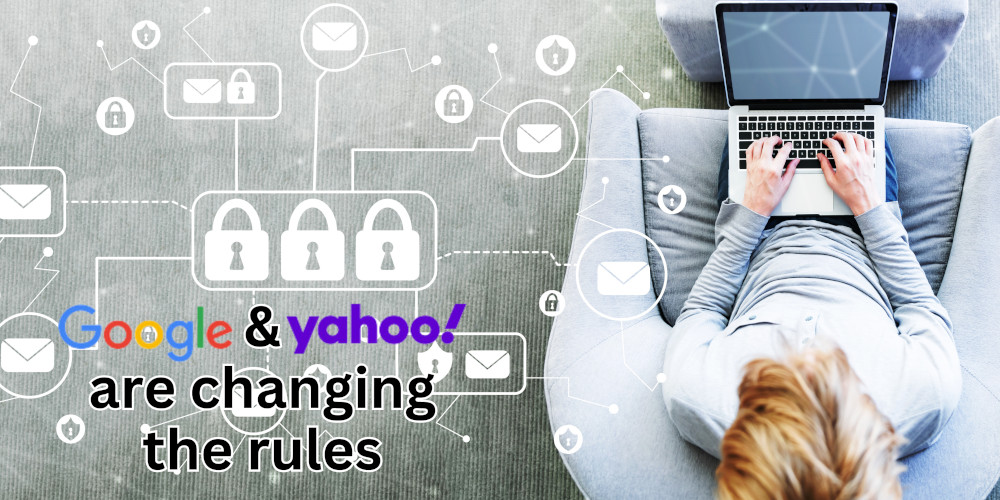Why Google and Yahoo are Changing the Rules for Email Senders
In the fast-paced world of business communication, securing your email correspondence is paramount. Achieving inbox delivery and safeguarding against spam can be effortless with strategic measures. As Google and Yahoo enforce new rules to enhance email security, here’s a guide to help your business effortlessly navigate these changes by the end of February 2024. Follow these simple steps to achieve uninterrupted email communication without undertaking complicated tasks or facing potential pitfalls. Your inbox security is just a few steps away!
What the Changes Mean for Every Email Sender
As of October 2023, Google and Yahoo, two major email service providers, have decided to enforce new rules to enhance email security and protect recipients from unwanted emails. While email authentication has always been a best practice, not all senders have embraced these practices, making it easier for bad actors to exploit vulnerabilities and compromise email security.
For every email sender, whether sending one email or millions, these changes signify a shift towards a safer, user-friendly, and spam-free email experience.
Checklist: 5 Steps to Ensure Compliance
Before you start, check the health of your email setup with the MX Toolbox email health check.
Step 1: Understand Your Email Domains
What is a domain?
Identify the domains you use for email sending. It’s like knowing the street addresses from which your letters are sent. Ensure proper authentication and status for each domain in your Postmark account. Think of it as ensuring each street address is secure and verified.
Action to take:
Identify the domains you use for email sending. Ensure proper authentication and status for each domain in your Postmark account.
Step 2: Authenticate Your Mail with Custom DKIM
What is DKIM?
DKIM (DomainKeys Identified Mail) is like a digital signature for your emails, confirming they come from a trusted source. Think of it as the sender’s unique stamp of approval. Implementing a custom DKIM signature is akin to creating a personalised stamp for your business.
Action to take:
Add a TXT record to your domain’s DNS settings to confirm legitimacy and trustworthiness. Doing this is like placing your stamp in a secure location.
Step 3: Authenticate Your Mail with Custom SPF
What is SPF?
SPF (Sender Policy Framework) is like a sender’s ID card, ensuring that emails are sent by authorised servers. It’s similar to showing your ID when entering a secure building. Setting up a custom Return-Path is like personalising your ID for better recognition.
Action to take:
Set up a custom Return-Path to authenticate your messages with SPF. You do this by adding a CNAME record pointing to pm.mtasv.net in your DNS settings. This is like updating your ID details.
Step 4: Set Up DMARC
What is DMARC
DMARC (Domain-based Message Authentication, Reporting & Conformance) is your email’s bodyguard, making sure it’s protected from impersonation. It’s like having a personal security detail for your emails. Setting up DMARC is like instructing this detail on how to handle potential threats.
Action to take:
Establish DMARC for your domain. This is like providing instructions to your email security team on monitoring and controlling email sources using DMARC policies.
Step 5: Register Your Domain for Google Postmaster Tools
What is Google Postmaster Tools?
Google Postmaster Tools is your surveillance system, keeping an eye on potential threats and ensuring your emails don’t go rogue. It’s like having security cameras for your emails.
Action to take:
Keep spam complaint rates below 0.3% and register your domain with Google Postmaster Tools. This is like maintaining a clean record and ensuring your surveillance system is active.
FAQ
Q. What happens if I send mail that doesn’t meet these requirements?
A. Messages might be rejected or sent to recipients’ spam folders.
Q. When will these changes take place?
A. Changes will roll out gradually from February 2024.
Q. How will this affect transactional senders?
A. Transactional senders, especially those exceeding 5,000 messages a day, should comply for enhanced deliverability and engagement.
Q. What is the bulk threshold for anti-spam policy?
A. Google specifies rules for users sending over 5,000 messages, while Yahoo doesn’t specify a particular volume or spam complaint rate threshold.
Q. Could these requirements and our understanding of them change?
A. Absolutely, and it’s expected. Stay informed and adapt to evolving email security standards.
Incorporating these steps into your email practices will not only ensure compliance with the new requirements but also contribute to a more secure and efficient email communication system. Embrace these changes proactively to protect your sender reputation and maintain a healthy email program. If you have further questions, refer to the FAQs or reach out for assistance. The online community is collaborating to create a safer environment for all users, and your adherence to these practices plays a crucial role in achieving this goal. If unsure, we can help you conduct a DNS audit.
Should you have any uncertainties or require assistance in implementing these crucial email security measures, our dedicated support team is here to guide you through the process or conduct a DNS audit to ensure your email domains are fully authenticated and optimised for the upcoming changes.
Resources:

